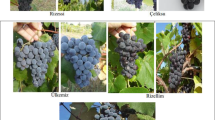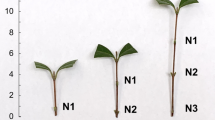Abstract
The presence of leaf in microcuttings of grape cvs. Arka Neelamani and Thompson Seedless promoted rooting in vitro (MS, 1 μM IAA, 0.1 μM GA3, 3% sucrose) but the effect varied depending on the number of leaves and position of the leaf on the cutting. Single node cuttings with a full-length lower internode and a lamina at top (LAT) showed earlier rooting and more root and shoot growth than cuttings with lamina positioned at the middle (LAM), while cuttings with a leaf at the base (LAB) of the cutting and full-length upper internode exhibited a lower percent rooting and sprouting, poor root and shoot growth, and low survival. Partial or complete removal of the upper internodal segment in LAB cuttings improved rooting and sprouting suggesting the possible operation of an inhibitory effect by the upper internode. Retaining an upper leaf in LAB cuttings (LAB+UL) resulted in necrosis of the upper leaf often followed by the lower one. The extent of necrotic damage was influenced by the leaf area and position or age of the cutting on the stock shoot. Retaining the lower internode in LAB and LAB+UL cuttings which held the node–leaf junction away from the medium, or reducing the concentration of MS medium helped significantly in improving the survival and performance of these cuttings. The difference in reaction between LAB and LAT cuttings was attributable mainly to the difference in the sensitivity of the stem part that came in contact with the medium. Removal of the leaf in LAB cuttings reduced this sensitivity. The majority of the LAB and LAB+UL cuttings, as well as non-rooting or delayed rooting LAT and LAM cuttings, exhibited high purple pigmentation of leaf, petiole and stem. Two-leafed cuttings in vitro showed poor survival, less rooting and low plantlet output compared to single-leafed cuttings.
Similar content being viewed by others
References
Bachelard EP & Stowe BB (1962) A possible link between root initiation and anthocyanin formation. Nature 194: 209-210
Cao Z (1990) Grape: micropropagation. In: Chen Z, Evans DA, Sharp WR, Ammirato RV & Sondhal MR (eds) Handbook of Plant Cell Culture, Vol 6, Perennial Crops (pp 312-328). Academic Press, New York
Davis TD (1988) Photosynthesis during adventitious rooting. In: Davis TD, Haissig BE & Sankhla N (eds) Adventitious Root Formation in Cuttings (pp 79-87). Dioscorides Press, Portland
Dixon RA (1985) Isolation and maintenance of callus and cell suspension cultures. In: Dixon RA (ed) Plant Cell Culture-A Practical Approach (pp 1-20). IRL Press, Oxford
Dore J (1965) Physiology of regeneration in cormophytes. In: Ruhland W (ed) Encyclopaedia of Plant Physiology, Vol 15/2 (pp 1-91). Springer, Berlin
Esau K (1953) Plant Anatomy. John Wiley & Sons, New York
Fahn A (1982) Plant Anatomy, 3rd edn. Pergamon Press, New York
Gifford EM & Foster AS (1989) Morphology and Evolution of Vascular Plants, 3rd edn. W. H. Freeman, New York
Haissig BE & Davis TD (1994) A historical evaluation of adventitious rooting research to 1993. In: Davis TD & Haissig BE (eds). Biology of Adventitious Root Formation (pp 275-332). Plenum Press, New York
Murashige T & Skoog F (1962) A revised medium for rapid growth and bioassays with tobacco tissue culture. Physiol. Plant 15: 473-497
Thomas P (1997) Increase in clonal propagation of ‘Arka Neelamani’ grape (Vitis vinifera) through induction of axillaries in in vitro layering technique. Indian J. Agric. Sci. 67: 594-596
Thomas P (1998) Contribution of leaf lamina of grape nodal microcuttings to rooting, root vigour and plantlet growth in vitro. J. Plant Physiol. 153: 727-732
Thomas P (1999) Relationship between tissue growth, CO2 level and tendril formation during in vitro culture of grape (Vitis vinifera L.). Vitis 38: 25-29
Thomas P (2000) Microcutting leaf area, weight, and position on the stock shoot influence root vigour, shoot growth and incidence of shoot tip necrosis in grape plantlets in vitro. Plant Cell Tiss. Org. Cult. 61: 189-198
Thomas P & Ravindra MB (1997) Effect of pruning or removal of in vitro formed roots on ex vitro root regeneration and growth in micropropagated grapes. Plant Cell Tiss. Org. Cult. 51: 177-180
Vidal N, Ballester A, Vietez AM, Kevers C & Gaspar T (1994) Biochemical characteristics of chestnut shoots related to in vitro multiplication and rooting capabilities. Adv. Hort. Sci. 8: 19-24
Author information
Authors and Affiliations
Rights and permissions
About this article
Cite this article
Thomas, P. Leaf number and position effects on the survival and performance of grape microcuttings in vitro, and the sensitivity of the cut nodal region to the medium. Plant Cell, Tissue and Organ Culture 65, 129–139 (2001). https://doi.org/10.1023/A:1010635714187
Issue Date:
DOI: https://doi.org/10.1023/A:1010635714187




